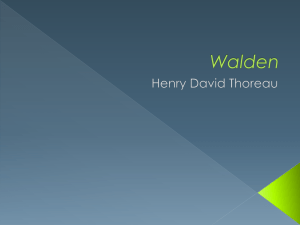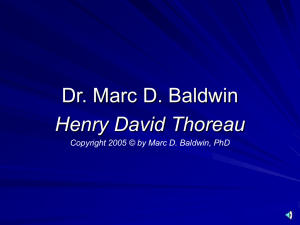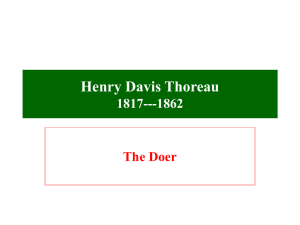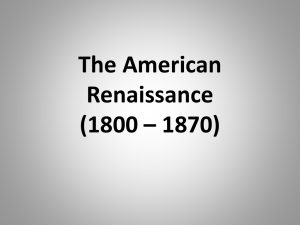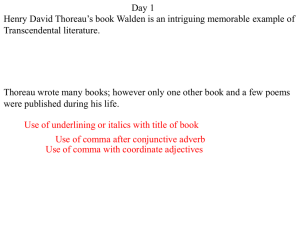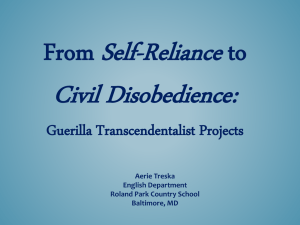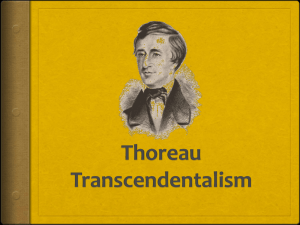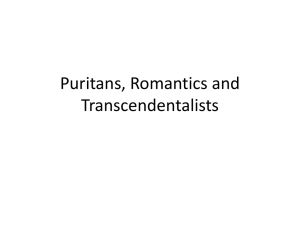Wallace Stevens in Cultural Context.
advertisement
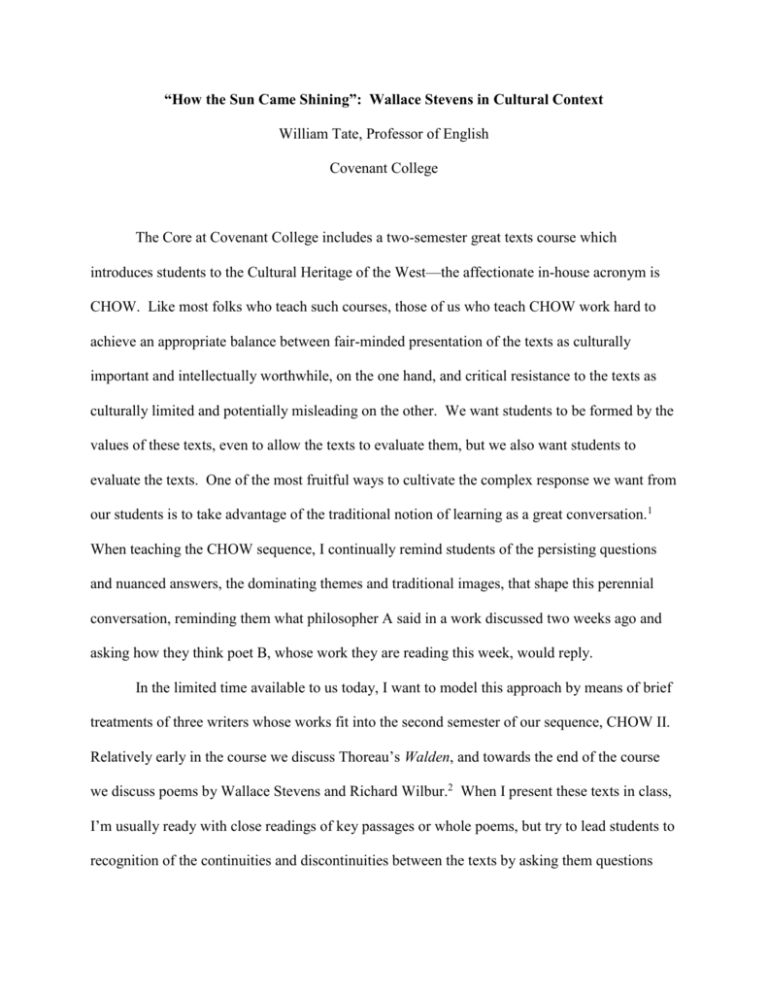
“How the Sun Came Shining”: Wallace Stevens in Cultural Context William Tate, Professor of English Covenant College The Core at Covenant College includes a two-semester great texts course which introduces students to the Cultural Heritage of the West—the affectionate in-house acronym is CHOW. Like most folks who teach such courses, those of us who teach CHOW work hard to achieve an appropriate balance between fair-minded presentation of the texts as culturally important and intellectually worthwhile, on the one hand, and critical resistance to the texts as culturally limited and potentially misleading on the other. We want students to be formed by the values of these texts, even to allow the texts to evaluate them, but we also want students to evaluate the texts. One of the most fruitful ways to cultivate the complex response we want from our students is to take advantage of the traditional notion of learning as a great conversation.1 When teaching the CHOW sequence, I continually remind students of the persisting questions and nuanced answers, the dominating themes and traditional images, that shape this perennial conversation, reminding them what philosopher A said in a work discussed two weeks ago and asking how they think poet B, whose work they are reading this week, would reply. In the limited time available to us today, I want to model this approach by means of brief treatments of three writers whose works fit into the second semester of our sequence, CHOW II. Relatively early in the course we discuss Thoreau’s Walden, and towards the end of the course we discuss poems by Wallace Stevens and Richard Wilbur.2 When I present these texts in class, I’m usually ready with close readings of key passages or whole poems, but try to lead students to recognition of the continuities and discontinuities between the texts by asking them questions 2 about the texts. Today I’ll abbreviate that procedure by suggesting very briefly what might be discovered in Thoreau, following that with a careful reading of part of a poem by Stevens, and then closing with a nod in the direction of Wilbur.3 Near the beginning of Walden, in a key passage, Thoreau explains his reasons for moving to the woods by talking about awakening as the highest achievement of a human being. “The morning,” he says, “is the awakening hour. Then there is least somnolence in us; and…some part of us awakes which slumbers all the rest of the day and night. Little is to be expected of that day,” he continues, “to which we are not awakened by our Genius…to a higher life than we fell asleep from…. After a partial cessation of sensuous life, the soul of man, or its organs rather, are reinvigorated each day, and his Genius tries again what noble life it can make” (393). Although Thoreau begins with the natural morning, he quickly moves to a metaphorical claim that the man who is fully awake makes his own morning. Since each man makes his own morning, as Thoreau sees it, the metaphorical awakening he has in view is a moral responsibility of the autonomous individual: Moral reform is the effort to throw off sleep. Why is it that men give so poor an account of their day if they have not been slumbering? …If they had not been overcome with drowsiness they would have performed something. The millions are awake enough for physical labor; but only one in a million is awake enough for intellectual exertion, only one in a hundred millions to a poetic or divine life.4 There isn’t time to develop the thought, but we should notice that Thoreau, commonly perceived as a nature-lover, here definitely subordinates physical life to something more soulish or spiritual, implying values similar to those expressed by Cartesian dualism. The “cessation of…sensuous life” in sleep benefits the body, no doubt, but this matters to Thoreau because the 3 body comprises the “organs” of “the soul of man.” That is, the body exists for the use of the soul. Thoreau continues by insisting that “We must learn to reawaken and keep ourselves awake…by an infinite expectation of the dawn.… Every man is tasked to make his life…worthy of the contemplation of his most elevated and critical hour.” This insistence immediately precedes what may be the best-known sentence from Walden, Thoreau’s famous declaration of motive: “I went to the woods because I wished to live deliberately” (394). In other words, Thoreau went to the woods because he wanted to keep himself awake, in the special sense in which he is using the word. At this key point in the text Thoreau makes a move that underscores the challenge of teaching a course like CHOW in a confessional context. The paragraph that begins with his decision to go to the woods “to live deliberately” ends by asserting that “most men…are in a strange uncertainty about…whether [life] is of the devil or of God, and have somewhat hastily concluded that it is the chief end of man here to ‘glorify God and enjoy him forever’” (395). When I teach this passage I sometimes begin the class by asking students “What is the chief end of man?” Most of them, at my Presbyterian school, recognize the first question of the Westminster Shorter Catechism and can answer, “Man’s chief end is to glorify God and enjoy him forever.” The point of Thoreau’s snarky allusion isn’t immediately clear. At first glance it might be taken as chastising a Christian focus on heavenly things to the exclusion of earthly things, a comprehensible and not uncommon misunderstanding of this question of the catechism. But we’ve just seen Thoreau himself valorizing the immaterial at the expense of the material, so this first impression seems, at best, in need of qualification. The context’s emphasis on autonomy indicates rather that Thoreau wants readers to resist submission to the authoritative confessional 4 document in favor of individual autonomy. In this sense, at least, Thoreau echoes the Cartesian suspicion of received authority, and Walden may be understood as Thoreau’s own elaboration of the cogito ergo sum.5 Moreover, his recommendation of self-reliance lies near the center of Thoreau’s cultural importance. When we consider this passage in class students often become aware, or more urgently aware, that some of their deeply rooted assumptions about the importance of individuality come from their American-after-Thoreau cultural context at least as much as from the Christian teaching of their homes and churches. Their awareness sometimes opens into critically alert and fruitful conversation. When I teach Thoreau in CHOW, I consciously resist closure. Instead of leaving Walden behind, I try to cultivate a dynamic conversation by following up on themes and images Thoreau uses when they reappear in the works of later thinkers. Thoreau’s use of sunrise and awakening as images of human fulfillment is echoed by Wallace Stevens’ use of the same images in “The Latest Freed Man.” In “The Latest Freed Man,” the awakening of the freed man appears as deliverance from dogmatism, a deliverance that is enabled and figured by the natural light of the sun. Like Thoreau, Stevens pictures freedom as a kind of Cartesian, naturalistic abandonment of conventionally received meanings which the man has come to perceive as imposed by authoritative tradition, including in his case the authority of revealed religion. Colin Gunton, a British theologian, notices the relevant attitude within Modernism. “Because it is believed that revelation takes away our autonomy and leaves us in thrall to the authority of others or of the impersonal other,” he says, “it becomes necessary to replace it with pure untrammelled reason.”6 As freedom from dogma, the freedom of Stevens’ freed man relies on his own “pure untrammelled reason,” including his individual sensibilities. Thus to be awake, as this poem presents it, is to rely on the self’s unmediated perceptions of the world. It means to be content 5 with unadorned physical fact; things first “say” what they are, and only take on meaning beyond their simple being when the poet constructs meaning for them. The poem opens with the moment of awakening during which the title character moves from implied enslavement under “the old descriptions of the world”7 into a freedom from what the poem calls “doctrine” (4, 8, and 10; compare “doctor” in 12 and 19). The man’s speech begins with his choice of agnosticism. Sitting “On the edge of his bed” and looking out at the world revealed by the rising sun, he says “I suppose there is / A doctrine to this landscape.” “Doctrine” here designates any inherited meaning imposed on the world, perhaps especially a religious meaning, and it is the particular character of awakening here that the man resists such doctrine. For him, “having just / Escaped from the truth, the morning is color and mist, / Which is enough” (4-6). In other words, the morning in itself is sufficient, without the imposition of meaning; the morning is merely color and mist, without doctrine. What the freed man is freed from, specifically, is “the truth,” understood as revealed or received, and therefore as absolute. As Eleanor Cook has noticed, “The Latest Freed Man” appears in a cluster of poems from the collection Parts of a World in which Stevens grapples with passages from John’s gospel such as Jesus’ words “I am the way, the truth, and the life,” and “you shall know the truth, and the truth shall make you free.”8 Though the title of this poem implies that knowing truth sets the latest freed man free, the freedom here, ironically, is not the freedom of knowing offered by Jesus, but a freedom characterized as not knowing: agnosticism. Rather than overtly recalling John’s gospel, the latest freed man alludes to Psalm 19, a locus classicus for Christian teaching concerning revelation. Here is the first portion of the psalm: 6 The heavens declare the glory of God; / and the firmament showeth his handiwork. / Day unto day uttereth speech, / and night unto night showeth knowledge. / There is no speech nor language, where their voice is not heard. / Their line is gone out through all the earth, /…/ In them [God] hath set a tabernacle for the sun, / Which is as a bridegroom coming out of his chamber, and rejoiceth as a strong man to run a race. (verses 1-5, Authorized Version, lightly modernized) The psalm opens by attaching a “doctrine” to the experience of the material world. According to the psalmist, natural objects speak because they have been made by God, and the psalm presupposes the intelligibility of this speech to human intelligence. Meaning inheres in the material world because the world is God’s handiwork. Especially relevant for understanding Stevens’ poem is the psalmist’s comparison of the sun to “a strong man.” According to the freed man, any meaning that may be is momentary. Although the freed man acknowledges the psalmist’s metaphor—“the moment’s sun” is “the strong man vaguely seen” according to line seven—from his point of view the natural sun “‘Overtak[es] the doctrine of th[e] landscape’” (8). The material sun, in other words, matters more than the metaphor attached to it. The metaphor is parenthetical and only “vaguely seen” when compared with the physical reality; the phenomenal trumps the noumenal. We may note in contrast that for Thoreau, the noumenal matters more than the phenomenal, so that like his Puritan predecessors, and unlike Stevens, he wants to read nature emblematically. That is, Thoreau looks at nature expecting to find a spiritual reality behind it; the sun must figure something, and Thoreau knows what it figures. For Stevens, the sun is just the sun until the poet assigns meaning to it. 7 Tacitly declaring the biblical comparison of the sun with a strong man outmoded, Stevens’ freed man offers a new simile for the sun, which “‘bathes in the mist / Like a man without a doctrine’” (9-10), so that the freed man awakens to a doctrine-free existence like that of the sun, which he affirms with an apparent tautology: “‘The light [the sun] gives— / It is how he gives his light’” (10-11). The sun just is what it is; it does what it does. To put it another way, in contrast with the doctrinal affirmation of Psalm 19, the poem’s tautological affirmation that the sun emits physical light implies a denial that the sun offers metaphysical light. Another biblical allusion gives the denial point. Continuing the thought, the freed man concludes that the way the sun shines “‘is how he shines, / Rising upon the doctors in their beds / And on their beds’” (11-13). The shift from “in their beds” to “on their beds” shows the doctors moving from lying down to sitting, so that their movement parallels the movement of the freed man who “rose at six and sat / On the edge of his bed” (2-3). “Doctors” here identifies those who accept doctrine, and the sun’s “rising upon the doctors” recalls Matthew 5:45, where Jesus says that God “maketh his sun to rise on the evil and on the good.” In Jesus’ saying, the righteous and the unrighteous are subject, under God’s providence, to the same natural forces, which demonstrate providence whether or not the recipients of their effects acknowledge it. The freed man’s paraphrase reverses the direction of Jesus’ teaching; regardless of what they may wish to make of it, the sun shines on the doctors in the same way that it shines on the freed man—that is, without signifying anything other than itself. It sheds light, but only physical light or, reversing the claim of Psalm 19, it does not declare the glory of God. The second part of the poem opens by recalling several features of the first part, but moves quickly to fuller explanation of their importance: “It was how the sun came shining into the room: / To be without a description of to be, / For a moment on rising at the edge of the bed, 8 to be” (14-16). The “moment” here echoes “the moment’s rain” and “the moment’s sun” from earlier lines (6-7), underscoring the temporary and fluid character of “description” relative to being. The freed man apparently chooses simple being rather than risk what might turn out to be delusory confidence in a traditional but unverifiable mythic explanation of being. Much more could be said about the details of this poem, but perhaps what I’ve already said is enough for our purposes today. For now we should notice a few features of this poem considered as an answer to Thoreau. Like Thoreau, Stevens accepts an essentially Cartesian dualism of soul and body. Though he seems in certain respects to have a higher regard for the physical world than Thoreau has, Stevens resembles Thoreau in doubting whether the soul or self can really know the physical world. Even more than Thoreau, Stevens lets the distance between human subject and natural object temper the impulse to objectify nature, though neither writer imagines a stable subject/object unity. For my students, reading Stevens has the potential salutary effect of unsettling thoughtless complacency with respect to either nature or language or both. As Stevens makes more explicit elsewhere, the imagination relates the experience of the mind to the external world by supplying the world with a narrative, but despite Stevens’ real appreciation for the physical world this narrative construct remains sharply distinct from that world and perpetually subject to revision. When I teach CHOW II, Richard Wilbur’s “Love Calls Us to the Things of This World” is usually the last text we consider, so Wilbur gets the last word in the semester’s conversation, though I hope students keep thinking and discussing after the final exam. Like Stevens’ “The Latest Freed Man,” Wilbur’s “Love Calls Us,” unfolds as the account of a man waking up at sunrise, in this case because of the noise made by another person working on laundry nearby. The man in Wilbur’s poem at first takes for granted something approximating the Cartesian 9 dualism that we have found in both Thoreau and Stevens. The man perceives sleep as allowing a separation of soul and body very like the “partial cessation of sensuous life” which Thoreau describes. Awakening feels to this man like a kidnapping in which the body snatches the soul away from its freedom to entrap it in the prison of the body. Despite opening similarities, the two poems reach rather different conclusions. While Stevens’ freed man, with deliberate agnosticism, holds the world at a distance, Wilbur’s waking man eventually rejects Cartesian distance in favor of participatory commitment, the “love” of the poem’s title. His final acceptance of the body, in its imitation of Christ’s kenotic incarnation, allows “clean linen for the backs of thieves.”9 That is, the poem cultivates a biblical parallel between laundered clothing and the forgiveness of sin, which it then takes as motivating committed life in the world. Laundry is washed in order to be worn, and souls are cleansed in order to participate in God’s love for the world precisely as embodied beings. In a much longer version of this paper, I offer rather full explications of Wilbur’s poem as well as Stevens’ poem. Here I will close with a single image from Wilbur’s. Echoing both Thoreau and Stevens, Wilbur juxtaposes awakening and sunrise, though he differs from his predecessors in using the images of sunrise and waking up to acknowledge human finitude and contingency. Thus he directs attention to the rightness of life in the body and the created goodness of the material world, saying “as the sun acknowledges / With a warm look the world’s hunks and colors, / The soul descends once more in bitter love / To accept the waking body” (2124). Like a number of words in this poem, “as” is ambiguous here. Most readers are likely to hear it initially as a synonym for “while.” In context, however, it also points towards simile: the sun’s acknowledgement of worldly “hunks” is like the soul’s acceptance of the body. In this 10 second meaning, “as” points towards the conclusion of the poem: love calls for a holism, rather than a dualism, of soul and body. My hope is that my presenting these particular works by Thoreau, Stevens, and Wilbur as voices in a conversation, will sensitize my students to the complexity of the cultural traditions which have already begun to shape them and will encourage them to find their own voices discussion. There isn’t space here to develop a theoretical defense of the conversation metaphor, but it is right to acknowledge that my practice has been substantially shaped by the work of the German philosopher Hans-Georg Gadamer. 2 The course is designed to include a unit on Modern poetry; the two particular poems I use here are supplemental texts when I teach them in my sections of the course. 3 In a much longer version of this paper, I provide detailed readings of the poems by Stevens and Wilbur. 4 Walden, in Thoreau: A Week, Walden, The Main Woods, Cape Cod (New York: Library Classics of the United States, 1985), 394. Hereafter cited parenthetically. 5 The second semester of CHOW begins with Descartes. 6 A Brief Theology of Revelation, 21, my italics. 7 Stevens: Collected Poetry and Prose (New York: Library Classics of the United States, 1997), 1; hereafter cited parenthetically by line number. 8 See Cook, Poetry, Word-Play, and Word-War in Wallace Stevens (Princeton: Princeton UP, 1988), 155-156. 9 Wilbur, Collected Poems, 1943-2004 (Orlando: Harcourt, 2004), 26; hereafter cited parenthetically by line number. 1
